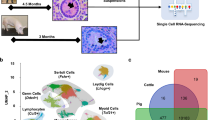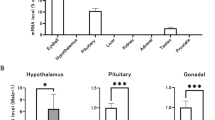ABSTRACT
A full length cDNA named HongrES1 was isolated and cloned by screening rat epididymis cDNA library using a mouse EST as a probe and 5′ RACE followed. It contained 1590bp nucleotides and its predicted protein had 415 amino acid residues including a serpin (serine protease inhibitor) conserved domain. Tissue distribution pattern showed it was specifically expressed in adult rat epididymis; moreover, in situ hybridyzation indicated this gene was expressed in a limited region of the cauda epididymis near vas deference. Such kind of expression pattern sugested that HongrES1 had potential function in male reproduction.
Similar content being viewed by others
INTRODUCTION
Spermatozoa in testis lack forward motility and the ability to fertilize eggs, and the role of the epididymis is to provide an environment in which structurally and functionally immature spermatozoa leaving the testis can be converted into fully functional cells 1. The epithelial cells form a luminal fluid environment by secreting proteins and fluid 2. There is a complex serie of interactions between epididymal secretions and spermatozoa as sperms migrate along the epididymis 4. About 150-200 proteins present in epididymal lumen 2. Many of these proteins cannot be detected in other tissues or are present in the epididymis as specific isoforms. Thus a complete characterization of all the specific proteins secreted by the epididymis would yield important information for understanding the molecular events of sperm maturation. Many of epididymis specific genes were found in monkey by our lab 3. HongrES1 was one of the 'by-products'when we tried to isolate the homologue of the monkey epididymis specific gene ESc-615 by screening rat cDNA library. sequence analysis indicated it was a new member of serpin (serine protease inhibitor) family.
In mammals, serpin s are expressed in many tissues and they regulate the activities of a diverse array of serine and cysteine proteases, controlling complement activation, blood coagulation, fibrinolysis, inflammation, tumor cell metastasis, apoptosis, neurite extension, and many other physiological processes 5. And it was also reported that several serpin's play important roles in male reproduction 6, 7, 8.
MATERIALS AND METHODS
Tissue samples
After the Sexually mature SD male rats were sacrificed, samples of epididymis, testis, kidney, liver, lung, heart, intestine, spleen, brain, vas deference, and prostate were obtained and immediately frozen in liquid nitrogen.
Probes and primers
P1(583): 5′ GTGCCTTCTCACTTTCCTCA 3′
P2(144): 5′ ATAAAGAGCAAACTTCCGGT 3′
P3(122): 5′ TAGATCCCGCAGTTCTTAGT 3′
Probe 1 (for screening): an 163bp PCR product of mouse EST with 73% homology with monkey ESc-615
Probe 2(for Northern blot): a 503bp fragment(16bp-519bp) of the screening product of HongrES1 after cutting by PstI(Takara)
Probe 3 (for in situ): a 550bp length PCR product of HongrES1 (532bp to 1081bp). Screening rat epidydimis library:
A bacteriophage cDNA library from sexsually mature rat epididymis constructed by our lab was screened by probe1. The screening procedure was provided by Stratagene company. About 50,000 bacteriophage plaques were screened. Hybidization procedure was as described previously 9 with 50°C hybidization temperature. Plaques with positive dots were selected and purified, and their phagemids were recovered and tranformed to Escherichia coli (SOLR) by in vivo excision (Stratagene). The finally selected fragments were sequenced by United Gene Holdings, Ltd.
5′ RACE
Total RNAs were isolated by acid phenol extraction 9 from rat epididymis.The first strand cDNA synthesis was processed as th recommendation of 5' RACE Kit (GIBCO) using primer P1 as specific prime. For 5' RACE, primer P2 was used as GSP1 specific primer in the first round of PCR amplification, and primer P2 was used as a nested specific primer in the second round of amplification. 5′ RACE product was cloned to pGEM-T Easy Vector (Promega) and sequenced by United Gene HoldingsLtd.
Northern blot analysis
The procedure was exactly the same as previously described 9, except 24 mg total RNA samples were applied on a 1.2 % agrose gel.
In situ hybridization
In situ hybridization was conducted according to the procedure previously described 9 using digoxigenin-labeled antisense and sense probes synthesized by in vitro transcription of the DNA of probe 3. The slides were hybridized at 58°C overnight, and stained for 1 h.
RESULTS AND DISCUSSION
Isolation and sequence analysis of HongrES1
An adult male rat epididymis library was screened with Probe 1, and 25 positive plaques were obtained. One of the insert with the size of 1092bp was named as HongrES1. Blast search showed it was a new gene. Probe 2 could hybridized with a mRNA (about 1.6kb) in rat epididymis in Northern blot analysis (data not show), indicating this screening product was not a full length cDNA. A 620bp DNA fragment was got after 5′ RACE. Altogether, the full-length of HongrES1 was 1590bp (Fig 1), and an ORF containing 415 amino acid residues was found by ORF Finder Program (http://www.ncbi.nlm.nih.gov/gorf/gorf.html) (Fig 1). There was a stop codon in the same reading frame upstream from ORF, and a signal peptide containing 45 amino acid residues was found by Signal Finder Program (http://www.cbs.dtu.dk/services/SignalP). A serpin signature from 377th amno acid residue to 387th amino acid residue was found by the software at the site: http://www.motif.genome.ad.jp/motif-bin/motif-markeq. Blast search found HongrES1 had 33% identities with a1-antitrypsin. This deduced amino acid sequence had conserved domain of SERPIN from 53rd amino acid residue to 404th amino acid residue by the program at the site: http://smart.embl-heidelberg.de/smart/show-motifs.pl. Taking together, it shows a new member of serpin s family was found. Blast search showed HongrES1 had high homology (33%) with a1-antitrypsin The necleotide sequence of HongrES1 has been submitted to the GenBank with accession number AY113703.
We predicted HongrES1 maybe not an inhibitory SERPIN, because the amino acids in the hinge region in RCL(reactive center loop) of HongrES1 were large polar residues (Lys, Asp, Glu, Se), but in inhibitory SERPIN these positions should be small residues such as Ala, Thr, Ser etc. Apart from the strange RCL sequence, HongrES1 had characteristics of alpha1-antitrypsin: Thr and Leu were at P1 and P1' of RCL, and the protein contained most of the conserved residues 10. But whether HongrES1 has inhibitory activity or not remains to be analyzed by experiments.
The expression of HongrES1 was epididymis specific in cauda region exclusively
Northern blot was used to determine the expression of HongrES1. Fig 2 showed that a strong signal was detected in epididymis, but there were not any signals in heart, liver, lung, kidney, intestine, testis, brain, spleen, prostate and vas deference. In situ hybridization with an antisense probe3 showed the expression of HongrES1 was restricted in a limited cauda region near vas deference (Fig 3), but there was not any signals at caput region. This expression pattern indicated HongrES1 probably played some roles in male reproduction. The research about HongrES1 will enrich our knowledge about the serpin family.
Localization of HongrES1 in rat epididymis by in situ hybridization (Blue regions were where HongrES1 was expressed) A, rat cauda epididymis (↑) and partial corpus (↑)(6.8×); B, rat caput epididymis(↑) and partial corpus (↑) (6.8×); C, epididymal duct in cauda hybridyzed with antisense of probe 3(40×); D, epididymis duct in cauda hybridized with sense of probe 3 (40×).
Accession codes
References
Leung PS, Chan HC, Chung YW, Wong TP, Wong PY . The role of local angiotensins and prostaglandins in the control of anion secretion by the rat eididymis. In: Russell C. Jones, Michael K. Holland, Christine Doberska, ed. The epididymis: cellular and molecular aspects. The journals of reproduction and fertility Ltd:1998: 15–22.
Dacheux JL, Druart X, Fouchecourt S, etc. Role of epididymis secretory proteins in sperm maturation with particular reference to the boar. In: Russell C. Jones, Michael K. Holland, Christine Doberska, ed. The epididymis: cellular and molecular aspects. The journals of reproduction and fertility Ltd: 1998:99–107.
Liu Qiang, Katherine G . Hamil, P . Sivashanmugam, et al. Primate epididymis-specific proteins: characterization of ESC42, a novel protein containing a Trefoil-like motif in monkey and human. Endocrinology 2001; 142(10):4529–39.
Tusiani DRP, Skudlarek MD, Holland MK, Orgebin-Crist M-C . Glycosylation of rat sperm plasma membrane during epididymal maturation. Biology of Reproduction 1993; 48:417–28.
Yuko S. Askew, Stephen C. Pak, Cliff J. Luke . SERPINB12 is a novel member of the human ov-serpin famiy that is widely expressed and inhibits trypsin-like serine proteinases. J Biol Chem 2001; 52: 49320–30.
Schill WB . Quantative determination of high molecular weight serum proteinase inhibitors in human semen. Andrologia 1976; 8(4):359–64.
Uhrin P, Dewerchin M, Hilpert M, Chrenek P, Schofer C, Geiger M, et al. Disruption of the protein C inhibitor gene results in impaired spermatogenesis and male infertility. J Clin Invest 2000; 106(12):1531–9.
Valérie Murer, Jean Francois Spetz, Ulrich Hengst, Ludger Maria Altrogge, Ariane de Agostini, Denis Monard . Male fertility defects in mice lacking the serine protease inhibitor protease nexin-1. Proc Natl Acad Sci USA 2001; 98 (6):3029–33.
Bin Li, Mei Sun, Bin He, Jin Yu, Yonglian Zhang . Identification of ifferentially expressed genes in human uterine leiomyomas using differential display. Cell Research, 2002; 12(1):39–45 .
Irving JA, Pike RN, Lesk AM, Whisstock JC . Phylogeny of the serpin superfamily: implications of patterns of amino acid conservation for structure and function. Genome Res 2000; 10(12):1845–64.
Acknowledgements
We express our heartfelt gratitude to Dr. James C. Whisstock in Department of Biochemistry and Molecular Biology of Monash University for his help in analysis of HongrES1 structure.
This work was supported by the Special Funds for Major State Basic Research Project (“973” No. G1999055901), State 863 High Technology R and D Project of China (No. 2001AA221211), Shanghai Development Foundation of Science and Technology (No. 01JC14046), Director foundation of Chinese Academy of Sciences, National Natural Science Foundation (No. 30100064 & 39893320), Special funds of Biological Science and Technology from Chinese Academy of Science, NIH Forgarty International Center Grant 1-R03-TW01490-01A, CFDA No. 93.934, and CAS knowledge creative program (KSCX2-SW-201).
Author information
Authors and Affiliations
Corresponding author
Rights and permissions
About this article
Cite this article
HU, Z., LIU, Q., SHANG, Q. et al. Identification and characterization of a new member of serpin family- HongrES1 in rat epididymis. Cell Res 12, 407–410 (2002). https://doi.org/10.1038/sj.cr.7290143
Received:
Revised:
Accepted:
Issue Date:
DOI: https://doi.org/10.1038/sj.cr.7290143
Keywords
This article is cited by
-
Molecular cloning and identification of mouse epididymis-specific gene mHong1, the homologue of rat HongrES1
Asian Journal of Andrology (2012)
-
Expression Patterns of Murine Antichymotrypsin-like Genes Reflect Evolutionary Divergence at the Serpina3 Locus
Journal of Molecular Evolution (2004)






